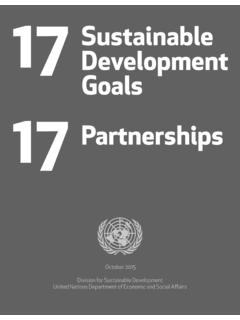Transcription of DFID Due diligence Framework - assets.publishing.service ...
1 Due diligence Guide Risk and Control Module 1 Introduction and purpose of The Due diligence Framework , responsibilities and process. Module 2 Risk based approach to due diligence Module 3 Assessing the Governance and Internal Control Pillar Module 4 Assessing the Ability to Deliver Pillar Module 5 Assessing the Financial Stability Pillar Module 6 Assessing the Downstream Activity Pillar Module 7 Due diligence Process map Module 8 Counter Terrorism Financing Module 9 multilateral Organisations Module 10 Private Sector Organisations Module 11 Frequently asked questions Module 1. Introduction and purpose of The Due diligence Framework , responsibilities and process. 1. The Due diligence Framework is a powerful risk management tool that encompasses activities undertaken to assist the Senior Responsible Owner (SRO) of the programme in obtaining assurance of a potential delivery partner's capacity and capability to deliver DFID aid. In reviewing the partner's capacity, systems, policies and processes, the SRO will gain a much better understanding of the strengths, weaknesses and risks in working with that partner, leading to a more informed and better managed intervention.
2 This assessment of delivery partner risk is in addition to the assurance given by the 1. multilateral Aid Review which focusses on effectiveness and value for money of multilateral organisations. 2. The Framework provides DFID with a consistent approach for conducting Due diligence during partner assessments and selection using an agreed set of guiding principles and assessment activities. These should be applied in a proportionate fashion taking account of the nature of the partner, the value and assessed risks of the planned intervention. 3. To improve accessibility, this guidance is presented in a segmented format with the core Framework document covering the high level principles with supporting sections covering the key elements of the Framework . In line with the Smart Rules, this approach is intended to help colleagues focus on the relevant issues at the relevant point in considering the assurance process. It recognises that one size does not fit all, empowering staff to decide on the level of detail required, which will be proportionate to the intervention and proposed partner.
3 4. This document: defines the design principles of the Framework , defines what Due diligence , in the DFID context is, outlines the respective responsibilities of the SRO, Risk and Control Unit and the business area, identifies factors to be considered when determining a proportionate application of the Framework , outlines processes to capture and share knowledge across DFID. Where useful, these are amplified and expanded upon in supporting modules. 5. SRO's are responsible for: determining the scope and depth of the Due diligence assessment as they are responsible for ensuring that they have sufficient assurance that the expenditure they approve will be correctly and appropriately applied for the purposes supported by the Business Case, ensuring all Due diligence assessments are submitted to for publication on the central Due diligence Register. 6. Risk & Control Unit is responsible for: maintaining the Due diligence policy, preparing and disseminating supporting resource material, maintaining a Due diligence Register of all assessments undertaken, create and maintain a Due diligence Community of colleagues involved in or interested in Due diligence , developing and providing training opportunities, providing support and advice on the Due diligence Framework .
4 2. 7. The Framework is built upon 6 underpinning design principles: Proportionality The scope and depth of the assessment is proportionate to the risk and value of the proposal recognising the balance to be achieved between seeking assurance and the need to minimise unnecessary burden on delivery partners. Assessments should be designed on a case by case basis with scrutiny and energy targeted towards the pillars where risks are deemed the greatest. Consistency of approach Due diligence will be applied consistently across DFID leading to increased comparability and quality of assessments. Evidence based Due diligence assessments will be based on the best and most current, objective and verifiable information available. SRO responsibility SRO's remain responsible for ensuring that appropriate levels of assurance have been obtained on all aid expenditure. Policy ownership Risk & Control Unit is the Business Area responsible for the Due diligence Framework and associated policies, guidance and support initiatives.
5 Knowledge sharing and co-ordination Risk and Control Unit will maintain a centralised repository of Due diligence assessments to create a knowledge bank for use across DFID. Assessments will remain valid for 3 years unless material changes have taken place within that timeframe. 8. The overarching principle is that, before working with any partner, we have a reasonable level of assurance that DFID aid will be correctly applied to achieve the desired objectives in the fashion agreed by the SRO. 9. However, given the wide range and complex nature of DFID's work, it is sensible to recognise that this must be applied on a case by case basis taking account of the context and the risks involved. 10. Therefore the general presumption is that Due diligence is necessary before all interventions. 11. The exceptions to this general rule are when: 3. the proposed intervention is a continuation of an existing programme (unless there has been a significant change in any factor) where existing programme management will monitor performance, a recent Due diligence Assessment has been carried out on the proposed partner and where this assessment covers the partner's activities in a similar or related sphere of activity.
6 Assessments have a lifespan of 3 years (unless there has been a significant change in any factor) and Spending Departments/SRO's can interrogate the Due diligence Register for previous assessments, in the case of financial aid to a partner Government where assurance will be provided through an existing Fiduciary Risk Assessment, In the case of contractors and/or suppliers, where assurance will be provided through existing procurement processes. 12. As outlined below, Due diligence is based on proportionality. This approach recognises that, for a variety of reasons either to do with the intervention itself of the proposed partner, a lower level of scrutiny may give sufficient assurance whilst more complex interventions will require more in depth scrutiny. Module 2 gives examples of risk factors to help SRO's assess the depth of assessment. 13. Reviewing implementing partners helps SRO's make evidence based assessments on the capacity and capability of existing and potential partners.
7 It provides assurance that our aid will be effective in delivering the desired impacts and provides SRO's with fundamental evidence to support risk management, monitoring and evaluation of capacity improvements in our partners. In particular, it informs the production of the Project Risk Register maintained by Programme team. 14. The process will provide an evidence based assessment of the risks involved in working with the potential partner and will inform the SRO on: whether funding should proceed, and if so, the extent to which capacity and capability building is required and what safeguards are needed and by when. This latter output provides a valuable input to ongoing programme management and monitoring and project partners must be monitored closely to ensure that they address the identified improvements as required by the assessment report. 15. The scope of assessments can be grouped into four broad pillars that focus on the potential partner's capacity and capability to deliver our aid programmes.
8 4. Assessment Pillars Governance Ability to Deliver Financial Stability Downstream and Control Partners Governance Due diligence Past Financial performance viability Fraud, bribery Management and corruption Staff capacity Framework /. Financial and capability contracts Management GGovnance Internal control Monitoring and and control Programme management Strength of Management audit Risk Fraud, bribery management and corruption Value for Money Ethics Policies, procedures and systems Modules 3 to 6 suggest the areas and typical questions which staff may wish to consider when undertaking the assessment. 16. Where appropriate and helpful, the programme team may find it useful to meet and interview representatives of the potential partner. Risk and Control Unit are available to give ad hoc advice on specific issues as required. 17. Assessments will usually begin with a desk based review and if deemed necessary by the SRO may be augmented with site visits and interviews with key personnel of the potential partner and/or relevant third parties.
9 5. 18. Where necessary, and with the prior agreement of Risk & Control Unit, Due diligence assessments can be supported by contractors. The Due diligence Invitation to Tender Pack includes the ITT Instructions, ITT Cover Letter and the Standardised Terms of Reference, which can be found at the following link: 19. Module 7 provides advice on how to carry out a Due diligence Assessment and includes a flowchart to outline the core process. 20. The primary purpose of the assessment is to give the SRO the required assurance needed to progress the intervention through the proposed partner. When appropriate, it will also highlight risks to be monitored and actions which should be progressed to mitigate risks. The Due diligence report template can be accessed via inSight. 21. If risks and/or control weaknesses are found they must be clearly identified and documented within the Assessment Report using the critical/high/medium/low rating outlined in the report template.
10 Remedial actions should be agreed with the potential partner and recorded in the MoU or specific partnership agreement agreement. 22. If critical weaknesses are identified, the SRO will need to make a decision on whether or not to proceed with the proposed funding. The rationale for the decision must be recorded as part of the SRO Comments section within the report. 23. The SRO must: use the Assessment Report to make a judgement on whether to proceed with the proposal, if proceeding, identify and record risk mitigation actions and timings required of the potential partner, include these requirements within the MoU or specific partnership agreement, use the Assessment Report as a baseline input to the programme management process, email a copy of the complete Assessment Report to which will be uploaded to the Due diligence Register. In line with the Smart Rules, it is the SRO's responsibility to review the content and quality of the assessment to enable them to make an informed decision on whether to proceed with the intervention or not.















